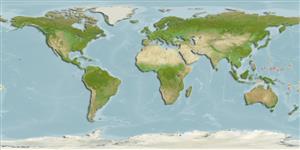>
Ovalentaria/misc (Various families in series Ovalentaria) >
Pomacentridae (Damselfishes) > Chrominae
Etymology: Chromis: Greek, chromis = a fish, perhaps a perch (Ref. 45335); abyssus: Name from Latin form of the Greek noun 'abyssos' meaning abyss, for the documentary film Pacific Abyss, produced by the British Broadcasting Corporation (BBC), which funded the expedition on which the type specimens were collected..
Environment: milieu / climate zone / depth range / distribution range
Ekologi
laut berasosiasi dengan karang; kisaran kedalaman 107 - 150 m (Ref. 90102). Tropical
Western Pacific: Palau.
Size / Weight / umur
Maturity: Lm ? range ? - ? cm
Max length : 9.8 cm SL jantan/; (Ref. 59379)
Duri punggung (Keseluruhan (total)): 14; duri punggung lunak (Keseluruhan (total)): 12-13; Duri dubur 2; Sirip dubur lunak: 12 - 14. This species is distinguished by the following characters: Dorsal rays XIV,12-13, usually 13; anal rays II,12-14, usually 13; pectoral rays 18-19, usually 19; spiniform caudal rays 3; tubed lateral-line scales 14-16; gill rakers 6-7 + 17-18, usually 7 + 18, total 24-25, usually 25; body depth 1.58-1.83 in SL; the color when fresh is dark gray with a large iridescent dark blue spot at center of each scale; membranes on median fins and pelvic fins opaque charcoal gray, with an iridescent dark blue margin on the spinous part of the dorsal and anal fins; caudal fin mottled iridescent dark blue and black; pectoral fins with a black ovoid spot covering the basal portion and pectoral-fin axis (Ref. 59379).
Adults appear to prefer depths more that 115 m, staying close to the substratum, sand and rubble slope with boulders and rock outcroppings. They take refuge in small caves and holes. Juveniles and some subadults were observed around limestone talus. Adults were usually solitary or in pairs, while subadults and juveniles were seen in small groups. Oviparous, distinct pairing during breeding (Ref. 205). Eggs are demersal and adhere to the substrate (Ref. 205). Males guard and aerate the eggs (Ref. 205). Other Chromis associated with this species include C. brevirostris, C. degruyi and C. earina (Ref. 59379).
Life cycle and mating behavior
Kematangan | Reproduksi, perkembang biakan | Pemijahan | telur-telur | Fecundity | Larva
Oviparous, distinct pairing during breeding (Ref. 205). Eggs are demersal and adhere to the substrate (Ref. 205). Males guard and aerate the eggs (Ref. 205).
Pyle, R., J.L. Earle and B.D. Greene, 2008. Five new species of the damselfish genus Chromis (Perciformes: Labroidei: Pomacentridae) from deep coral reefs in the tropical western Pacific. Zootaxa 1671:3-31. (Ref. 59379)
Status IUCN Red List (Ref. 130435)
ancaman kepada manusia
Harmless
penggunaan manusia
informasi lanjut
AcuanBudidaya airprofil budidaya airStrainGenetikaElectrophoresesDiturunkanPenyakit-penyakitPengolahanNutrientsMass conversion
mitraGambarStamps, Coins Misc.Suara-suaraCiguateraKecepatanTipe renangArea insangOtolithsOtakPenglihatan / visi
Alat, peralatan
laporan khas
muat turun XML
Sumber internet
Estimates based on models
Preferred temperature (Ref.
123201): 9 - 26.8, mean 15.9 °C (based on 47 cells).
Phylogenetic diversity index (Ref.
82804): PD
50 = 0.5000 [Uniqueness, from 0.5 = low to 2.0 = high].
Bayesian length-weight: a=0.01778 (0.00796 - 0.03971), b=2.99 (2.81 - 3.17), in cm total length, based on LWR estimates for this Genus-body shape (Ref.
93245).
Trophic level (Ref.
69278): 3.0 ±0.1 se; based on size and trophs of closest relatives
Daya lenting (Ref.
120179): Tinggi, Waktu penggandaan populasi minimum kurang dari 15 bulan (Preliminary K or Fecundity.).
Fishing Vulnerability (Ref.
59153): Low vulnerability (10 of 100).
